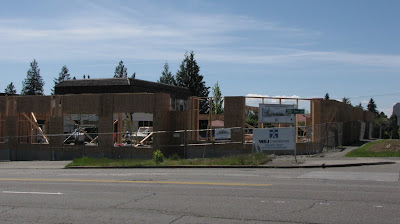
The final stages before the concrete is poured to form our floor!

The plastic tubing that you see here is placed on top of the rebar grid and will be encased in the concrete slab of the floor. A water/antifreeze solution will be ran through the pipe system, and will be heated by an external furnace. The heat will basically radiate through the floor and since heat rises, will provide the heat for the shop. The burner will be run on "waste" oil, which is the used oil from oil changes. This reduces dependency on natural gas, fossil fuels and electricity to provide a more "green" method of heating while also reducing the amount of the toxic waste that is created as used engine oil. Our current location is heated by a waste oil burner, albeit not through the heated floor method.

This will be the future car wash bay, a welcome change for our car wash specialists who are used to having to work outside. (Especially in rainy or cold weather!)

This is where two of the vehicle bays will be. Each technician will have two bays a piece, one with an "in-ground" vehicle hoist (the rectangle object is where the posts will be installed) and the other with an "above-ground" hoist. Although "in-ground" hoists are usually preferred by technicians, (easy to use, very minimal space interruption) they are limiting with exhaust work and other under-body repairs that the arms of the hoist interfere with. "Above-ground" lifts allow complete access to the under body of the vehicle, however, are cumbersome in that the two beams that support the hoist (imagine working around a giant steel doorway or arch) can become an obstacle when going from the vehicle to the tech's toolbox.











































